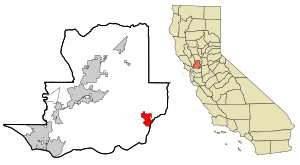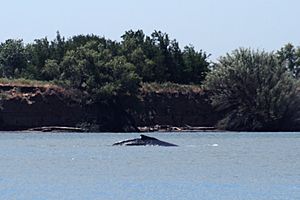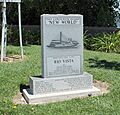Rio Vista, California facts for kids
Quick facts for kids
Rio Vista, California
|
|
|---|---|
| City of Rio Vista | |
| Motto(s):
The Gateway to the Delta
|
|

Location in Solano County and the state of California
|
|
| Country | United States |
| State | California |
| County | Solano |
| Incorporated | January 6, 1894 |
| Area | |
| • Total | 7.09 sq mi (18.37 km2) |
| • Land | 6.59 sq mi (17.07 km2) |
| • Water | 0.50 sq mi (1.30 km2) 5.68% |
| Elevation | 20 ft (6 m) |
| Population
(2010)
|
|
| • Total | 10,217 |
| • Density | 1,443.08/sq mi (556.18/km2) |
| Time zone | UTC-8 (Pacific) |
| • Summer (DST) | UTC-7 (PDT) |
| ZIP code |
94571
|
| Area code | 707 |
| FIPS code | 06-60984 |
| GNIS feature IDs | 277585, 2410955 |
Rio Vista is a city in California, located in the eastern part of Solano County. Its name comes from Spanish words meaning "River View." It's found in the Sacramento River Delta area of Northern California. In 2010, about 7,360 people lived there.
Contents
About Rio Vista
Rio Vista is a small city in Solano County. It is about 50 miles (80 km) south of Sacramento. The city is located right on the Sacramento River in the Sacramento River Delta.
Land and Water
The city covers a total area of about 7.1 square miles (18.4 square kilometers). Most of this area, about 6.7 square miles (17.4 square kilometers), is land. The rest, about 0.4 square miles (1.0 square kilometer), is water. Water makes up about 5.68% of the city's total area.
Weather in Rio Vista
Rio Vista has a warm-summer Mediterranean climate. This means it has hot, dry summers and mild, wet winters. This type of climate is often seen in areas around the Mediterranean Sea.
History of Rio Vista
The city of Rio Vista has an interesting past. The first settlement was actually a few miles north of where the city center is today.
Early Beginnings
In 1858, a man named Colonel Nathan H. Davis started a settlement called "Brazos del Rio." This was near the Sacramento River. Later, the name was changed to "Rio Vista." In 1862, a big flood hit the area. Because of the flood, the town had to move to higher ground. The new location is where Rio Vista is today. The city officially became a town on December 30, 1893.
Army and Coast Guard Presence
From 1911 to 1992, Rio Vista was home to a United States Army Reserve center. This facility was first used by the U.S. Army Corps of Engineers to manage river activities. In the 1950s, it stored and maintained boats for the U.S. Army Transportation Corps. Later, in the 1960s and 1970s, it was used to get amphibious vehicles ready for transport to Vietnam. Soldiers were also trained there to use these vehicles. The center closed in 1992. Rio Vista also has a United States Coast Guard station, which opened in 1963.
Humphrey the Whale's Visit
In 1985, a lost humpback whale named "Humphrey" swam all the way up the Sacramento River. This was unusual because Rio Vista is about 60 miles (97 km) from the Pacific Ocean! Many people came to see Humphrey. Rescuers, with help from the Army Reserve, guided him back to the sea.
In May 2007, two more humpback whales, named "Delta" and "Dawn" (a mother and her calf), were seen near Rio Vista. They stopped in the river close to the town a couple of times.
Land Purchases by Flannery Associates
Starting in 2018, a group of investors called Flannery Associates began buying a lot of land around Rio Vista. This group is part of a company called California Forever. They even sued some people who did not want to sell their land.
Population of Rio Vista
The population of Rio Vista has grown over the years. Here's a look at how many people have lived in the city at different times:
| Historical population | |||
|---|---|---|---|
| Census | Pop. | %± | |
| 1870 | 319 | — | |
| 1880 | 666 | 108.8% | |
| 1890 | 648 | −2.7% | |
| 1900 | 682 | 5.2% | |
| 1910 | 884 | 29.6% | |
| 1920 | 1,104 | 24.9% | |
| 1930 | 1,309 | 18.6% | |
| 1940 | 1,666 | 27.3% | |
| 1950 | 1,831 | 9.9% | |
| 1960 | 2,616 | 42.9% | |
| 1970 | 3,135 | 19.8% | |
| 1980 | 3,142 | 0.2% | |
| 1990 | 3,316 | 5.5% | |
| 2000 | 4,571 | 37.8% | |
| 2010 | 7,360 | 61.0% | |
| 2019 (est.) | 9,718 | 32.0% | |
| U.S. Decennial Census | |||
Population in 2010
In 2010, Rio Vista had a population of 7,360 people. Most residents, about 81.6%, were White. About 5.1% were African American, and 4.9% were Asian. People of Hispanic or Latino background made up about 12.4% of the population.
There were 3,454 households in the city. About 18.1% of these households had children under 18. The average household had 2.13 people. The median age in Rio Vista was 57.2 years old. This means half the people were older than 57.2 and half were younger.
Population in 2007
In 2007, there were 7,876 people living in Rio Vista. The median income for a household was $44,534. This means half of the households earned more than this amount, and half earned less. About 10.2% of the population lived below the poverty line.
A large housing development called Trilogy at Rio Vista is located near the city. It is designed for adults who are 55 and older. This community includes an 18-hole golf course.
Industries in Rio Vista
Rio Vista has several important industries that provide jobs and support the local economy.
Natural Gas and Energy
Natural gas was found in the Rio Vista area in 1936. The Rio Vista Gas Field became a major source of jobs for many years. Today, companies like California Resources Corporation manage the gas operations.
The area also has many wind turbines. There are over 750 wind turbines on the Montezuma Hills nearby. These turbines are part of three renewable energy projects. They help produce clean energy for the region. There are plans to add even more wind turbines.
Other Industries
Besides natural gas, other important industries in Rio Vista include farming, manufacturing, and tourism. Rio Vista is home to the largest American producer of Belgian Endive, which is a type of leafy vegetable.
Craig Breedlove, a famous person who set five world land speed records, used to live in Rio Vista. He also had an engineering facility in the city.
Transportation
The city has its own airport, the Rio Vista Municipal Airport. It is also located along California State Route 12. This highway crosses the Sacramento River using the Helen Madere Memorial Bridge, which is often called the Rio Vista Bridge.
Notable Residents
- Craig Breedlove – A famous person who holds world records for car speed.
- Bill Wight – A former professional baseball pitcher and scout.
Images for kids
See also
 In Spanish: Río Vista (California) para niños
In Spanish: Río Vista (California) para niños












